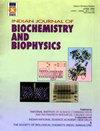Generating a potent inhibitor against MCF7 breast cancer cell through artificial intelligence based virtual screening and molecular docking studies
IF 1.5
4区 生物学
Q4 BIOCHEMISTRY & MOLECULAR BIOLOGY
引用次数: 0
Abstract
Artificial Intelligence (AI) has been widely adopted by pharmaceutical industry to aid rationally drug design and development by fostering the quick delivery of drug targets with optimized structures in spite of huge chemical space of >1060 drug molecules. Tamoxifen, Selective Estrogen Receptor Modulator (SERM), is the drug for breast cancer cell, MCF 7 with many side effects. Tamoxifen may cause side effects like increased bone or tumor pain, pain or reddening around the tumor site, hot flashes, nausea and excessive tiredness etc., Therefore, compound which can resist ER’s bioactivity is considered as an important target for treating breast cancer. In this study, AI based Virtual Screening (VS) method using an efficient Generative Neural Network (GNN) model has been experimented to generate high inhibitory potential hit drug-like inhibitors. Physicochemical, Pharmacokinetic and toxicity analysis are carried out for conforming the sub-selection of drug-likeness of inhibitors. Additionally, Molecular Docking studies with DNA (355D) and protein (3EU7) are performed for the evaluation of binding affinity, prediction of intermolecular interactions and inhibition constant. The docked results of the inhibitor M22 (methyl 2-[(2-benzoylphenyl) carbamoyl] benzoate) has low free energy of binding (-8.61 Kcal/mol and -8.05 Kcal/mol) and low Inhibition constant, Ki, value (0.486 μM and 1.25 μM) as compared to Tamoxifen (-6.7 Kcal/mol & -5.62 Kcal/mol and 12.2 μM & 75.85 μM). Thus, minimum amount of the M22 inhibitor is enough as compared to Tamoxifen and M22 has 3 benzene rings, extended conjugation, amide linkage and huge number of labile electrons which facilitates as a potent drug. This study provides a greenish path to synthesise a potent inhibitor, M22, for further experimental studies rather than preparing number of inhibitors on the atom economy way.通过基于人工智能的虚拟筛选和分子对接研究,生成一种有效的MCF7乳腺癌细胞抑制剂
尽管药物分子的化学空间巨大,但人工智能(AI)已被制药行业广泛采用,通过促进具有优化结构的药物靶点的快速递送,来帮助合理的药物设计和开发。三苯氧胺,选择性雌激素受体调节剂(SERM),是治疗乳腺癌细胞mcf7的药物,有许多副作用。他莫昔芬可能引起骨痛或肿瘤疼痛加重、肿瘤部位周围疼痛或发红、潮热、恶心和过度疲劳等副作用,因此,能够抵抗ER生物活性的化合物被认为是治疗乳腺癌的重要靶点。本研究利用高效的生成神经网络(GNN)模型,实验了基于人工智能的虚拟筛选(VS)方法,生成高抑制电位的药物样抑制剂。进行了理化、药代动力学和毒性分析,以符合抑制剂的药物相似性亚选择。此外,还进行了与DNA (355D)和蛋白质(3EU7)的分子对接研究,以评估结合亲和力,预测分子间相互作用和抑制常数。与他莫西芬(-6.7 Kcal/mol和-6.7 Kcal/mol)相比,抑制剂M22(2-[(2-苯甲酰苯基)氨基甲酰苯甲酸甲酯)具有较低的结合自由能(-8.61 Kcal/mol和-8.05 Kcal/mol)和较低的抑制常数Ki值(0.486 μM和1.25 μM);-5.62 Kcal/mol和12.2 μM &75.85μM)。因此,与他莫昔芬相比,M22抑制剂的用量最少就足够了,而且M22具有3个苯环、扩展偶联、酰胺键和大量的不稳定电子,有利于成为一种强效药物。本研究为进一步的实验研究提供了一条绿色的途径来合成一种有效的抑制剂M22,而不是以原子经济的方式制备大量的抑制剂。
本文章由计算机程序翻译,如有差异,请以英文原文为准。
求助全文
约1分钟内获得全文
求助全文
来源期刊

Indian journal of biochemistry & biophysics
生物-生化与分子生物学
CiteScore
2.90
自引率
50.00%
发文量
88
审稿时长
3 months
期刊介绍:
Started in 1964, this journal publishes original research articles in the following areas: structure-function relationships of biomolecules; biomolecular recognition, protein-protein and protein-DNA interactions; gene-cloning, genetic engineering, genome analysis, gene targeting, gene expression, vectors, gene therapy; drug targeting, drug design; molecular basis of genetic diseases; conformational studies, computer simulation, novel DNA structures and their biological implications, protein folding; enzymes structure, catalytic mechanisms, regulation; membrane biochemistry, transport, ion channels, signal transduction, cell-cell communication, glycobiology; receptors, antigen-antibody binding, neurochemistry, ageing, apoptosis, cell cycle control; hormones, growth factors; oncogenes, host-virus interactions, viral assembly and structure; intermediary metabolism, molecular basis of disease processes, vitamins, coenzymes, carrier proteins, toxicology; plant and microbial biochemistry; surface forces, micelles and microemulsions, colloids, electrical phenomena, etc. in biological systems. Solicited peer reviewed articles on contemporary Themes and Methods in Biochemistry and Biophysics form an important feature of IJBB.
Review articles on a current topic in the above fields are also considered. They must dwell more on research work done during the last couple of years in the field and authors should integrate their own work with that of others with acumen and authenticity, mere compilation of references by a third party is discouraged. While IJBB strongly promotes innovative novel research works for publication as full length papers, it also considers research data emanating from limited objectives, and extension of ongoing experimental works as ‘Notes’. IJBB follows “Double Blind Review process” where author names, affiliations and other correspondence details are removed to ensure fare evaluation. At the same time, reviewer names are not disclosed to authors.
 求助内容:
求助内容: 应助结果提醒方式:
应助结果提醒方式:


